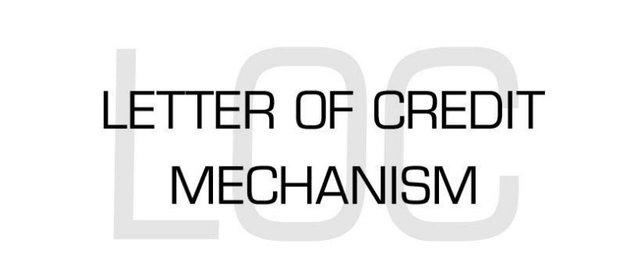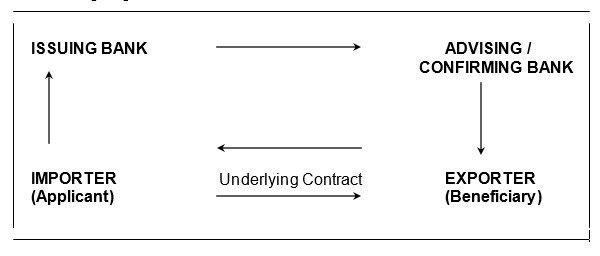Letter Of Credit Mechanism Foreign Trade Operations
In simple terms, letter of credit is an undertaking by a bank to make a payment to a named beneficiary within a specified time, against the presentation of documents which comply strictly with the terms of the letter of credit.

Its main advantage is providing security to both the exporter and the importer, but the security offered however, comes at a price and must be weighed against the additional costs resulting from bank charges. The exporter must understand the conditional nature of the letter of credit and the fact that payment will not be made unless the terms of the credit are met precisely.
An importer / buyer (Applicant) may open a letter of credit if they wish to ensure that the exporter/seller (Beneficiary) has performed those requirements as per the underlying sales contract, by making the documentation requested conditions of the credit. (N.B. The sales contract is not an inherent part of the letter of credit, although the Letter of Credit may contain a reference to such contract).
When an exporter asks for payment by letter of credit, he is transferring the risk of non-payment by the buyer to the Issuing Bank and the Confirming Bank if the letter of credit is confirmed, providing the exporter presents the required documents in strict compliance with the credit, with the exception of cash in advance. For the exporter a letter of credit is the most secure method of payment in international trade provided the terms of the credit are met.
The following diagram shows those involved in a letter of credit transaction.

All parties in the Letter of Credit transaction deal with documents, not goods.
DOCUMENTARY LETTER OF CREDIT
The documentary credit is an irrevocable commitment made by a bank (issuing bank), at the request of its importer client (applicant) to pay a sum of money to an exporter (beneficiary), against presentation of documents complying with the terms of the credit within a set time limit. The documentary credit is internationally recognized and subject to the uniform customs and practices (UCP) for documentary credits of the International Chamber of commerce (ICC).
As an effective, fast and recognized means of securing and processing payments, the documentary credit is the most complete risks coverage instrument.
PRINCIPLE OF DOCUMENTARY LETTER OF CREDIT
The documentary credit is a technique for financing international trade by which a bank
(issuing bank) takes the commitment, at the request and for the account of its client (applicant), to pay the exporter (beneficiary) against the handing-over of various documents complying with the terms of the credit, proving forwarding and the nature of the goods stipulated in the commercial contract. The documentary credit is subject to the uniform customs and practices (UCP) of the International Chamber of Commerce (ICC), which are recognized and applied worldwide. The latest version of the UCP, published in 1993, became effective on July 1st, 2007 (the reference today is publication No 600).
PARTIES INVOLVED:
• The Applicant:
Is the buyer (importer) and gives instructions to open a documentary credit.
• The Issuing bank:
Is the buyers bank (generally located in the buyer’s country) which issues the documentary credit.
• The Advising bank:
Is the issuing bank's agent (generally located in the seller’s country) which forwards or advises the documentary credit to the beneficiary without making a commitment in favour of the latter.
• The Confirming bank:
Is generally the advising bank which undertakes to pay the beneficiary rather than waiting for the issuing bank to pay.
• The Beneficiary:
Is the seller (exporter) to whom the documentary credit is issued.
PROCEDURE
STEP 1:
• CONCLUSION OF COMMERCIAL CONTRACT
The seller and the buyer come to an agreement and sign the commercial contract: the settlement will be carried out by documentary credit.
STEP 2:
• INITIAL REQUEST FOR DOCUMENTARY CREDIT
The buyer requests his bank to open a documentary credit in favor of the seller.
STEP 3:
• ISSUANCE OF THE DOCUMENTARY CREDIT
The buyer's bank (issuing bank) issues the DC and sends it to a correspondent bank in the seller's country.
STEP 4:
• NOTIFICATION OR CONFIRMATION OF THE DC
The correspondent bank (advising or confirming bank) authenticates and advises the DC to the seller.
STEP 5:
• SHIPMENT OF GOODS
The seller ships the goods.
STEP 6:
• AVAILABILITY OF DC
The seller presents documents to the correspondent bank for payment/negotiation/acceptance. The correspondent bank checks the documents and pays the seller if the documents are conform to the terms and conditions of the documentary credit.
STEP 7:
• SENDING OF DOCUMENTS
The correspondent bank sends the documents to the issuing bank and claims the payment.
STEP 8:
• DELIVERY OF DOCUMENTS TO THE APPLICANT AND RECEPTION OF GOODS
The issuing bank delivers the documents to the buyer after settlement. The buyer presents the documents for the delivery of goods.
AVAILABILITY UNDER DOCUMENTARY CREDITS:
• BY SIGHT PAYMENT:
The payment is made against presentation of documents in conformity with the credit.
• BY DEFERRED PAYMENT:
The seller grants a term of payment to the buyer (payment after a period specified in the documentary credit without any draft required)
• BY ACCEPTANCE:
This mode of payment is similar to the deferred payment but the beneficiary issues a draft that must be drawn on the advising /confirming or issuing bank. The exporter receives the acceptance of the draft from the advising/confirming or issuing bank undertaking that the payment will be effected at maturity.
• BY NEGOTIATION:
Negotiation means the giving of value by the nominated bank or every other bank to the beneficiary against drafts and/or the stipulated documents.
SHIPPING DOCUMENTS:
- Bill of Exchange
- Bill of Lading
- Commercial Invoice
- Packing List
- Certificate of Origin (CCIE)
- Shipment Adivce
- Insurance Policy
- Inspection Certificate
- Health Certificate (Live Stock)
- Analysis Certificate
- Weight Certificate
- End User certificate
- Consular Certificate
- ETC
METHODS OF L/C SETTLEMENT:
- Nostrum / Vostro accounts
- Claim Reimbursement
- We will pay you after receiving of documents at our Interpretations
Advising Bank - Bank that receives a letter of credit from the issuing bank for authentication and delivery to the beneficiary. The advising bank is usually a correspondent of the issuing bank located in the same country as the beneficiary.
Applicant - Party requesting that a letter of credit be opened.
Bill of Exchange - Formal written order addressed by one person (drawer) to another (drawee), signed by the drawer, and directing the drawee to pay on demand or at a fixed or determinable future time, a certain sum in money to the order of a specified person (payee).
Bill of Lading (Air, Ocean, Railroad, Truck) - A document of title issued by the carrier (transport company) or its agent. Bill of lading is a receipt for the merchandise in transit, as well as a contract for delivery to a specified party at a specified destination.
Beneficiary - Party in whose favor a letter of credit is issued, who is entitled to present documents required by the L/C and receive payment.
Cash Against Documents - Term (abbreviated as CAD) for documentary collection instructions requesting the presenting bank to deliver documents only upon receipt of payment from the drawee/importer. (The same as, "documents against payment.")
Collecting Bank - Bank that acts as an agent for a remitting bank that wishes to have its collections handled. The collecting bank demands payment from the buyer and handles the funds received as instructed; generally the funds are sent back to the remitting bank.
Commercial Invoice - A bill for the goods from the seller to the buyer. These invoices may be used by governments to determine the true value of goods when assessing customs duties.
Confirming Bank - Bank that has added its confirmation to a letter of credit. This term is also sometimes used loosely to refer to a bank that has issued a commitment to purchase letter of credit documents without recourse, a practice called "silent confirmation."
Deferred Payment - Payment a set time after shipment or presentation of shipping documents, as opposed to immediately or "at sight." A distinction is drawn between a letter of credit that is available for deferred payment and one that is available for acceptance of time drafts in that no drafts are involved under a deferred payment L/C. Without accepted drafts, the beneficiary’s ability to sell, or "discount," his right to payment to another lender or investor is restricted.
Discrepancies - Term used to describe deviations between documents presented and requirements set in the letter of credit or inconsistencies among the documents themselves.
Issuing Bank - Bank that draws up and issues the letter of credit and that makes payment according to the conditions.
Inspection Certificate - A document that is required by some purchasers and countries in order to attest to the specifications of the goods shipped. This is usually performed by an independent third party that will inspect the goods for conformity.
Irrevocable Letter of Credit - Letter of credit that cannot be amended or canceled without agreement of both the beneficiary and the issuing bank. Any letter of credit subject to the UCP600 or to US law is irrevocable unless it specifies otherwise.
Maturity Date - The date on which negotiable instruments become due for payment.
Negotiating Bank - Bank to which letter of credit documents are presented by the beneficiary for collection of payment. The name derives from the fact that the negotiating bank is normally authorized by the issuing bank to negotiate documents (see "negotiate"), but it may or may not choose actually to do so.
Paying Bank - Bank that effects payment of documents negotiated under a letter of credit, customarily the buyer's bank. It is usually also the negotiating bank, unless the L/C allows another bank to negotiate or the paying bank is unable to negotiate. See also "negotiating bank".
Reimbursing Bank - In a letter of credit transaction, the bank with which the issuing bank maintains an account and which is authorized by the issuing bank to charge that account to pay claims received from the negotiating bank for documents that have been presented.
Remitting Bank - In a draft collection transaction, the first bank in the chain of collection; the principal’s or seller’s bank.
Revocable Letter of Credit - Letter of credit that can be amended or canceled at any time without notice to or consent of the beneficiary. A letter of credit that is subject to the UCP500 or to US law is revocable only if it clearly states this on the L/C.
Sight Draft - Draft that demands payment "at sight," or immediately, as opposed to a time draft, which may be payable "90 days after sight" or "30 days after bill of lading date."